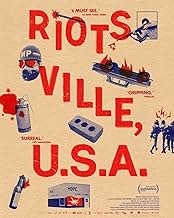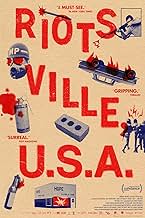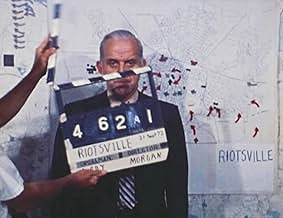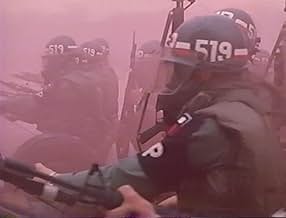Benvenuti a Riotsville, una città immaginaria costruita dall'esercito americano.Benvenuti a Riotsville, una città immaginaria costruita dall'esercito americano.Benvenuti a Riotsville, una città immaginaria costruita dall'esercito americano.
- Premi
- 4 vittorie e 10 candidature totali
Lyndon B. Johnson
- Self
- (filmato d'archivio)
Otto Kerner
- Self - Chairman
- (filmato d'archivio)
- (as Governor Otto Kerner)
Edward P. Morgan
- Self - PBL Chief Correspondent
- (filmato d'archivio)
Robert Curvin
- Self - Former Chairman, Neward CORE
- (filmato d'archivio)
Leonard Kowalewski
- Self - Newark Police
- (filmato d'archivio)
John Harrington
- Self - Fraternal Order of Police
- (filmato d'archivio)
- (as Sgt. John Harrington)
Albert Cleage
- Self
- (filmato d'archivio)
- (as The Rev. Albert Cleage)
Alvin F. Poussaint
- Self - Tufts University
- (filmato d'archivio)
- (as Dr. Albert Poussaint)
Fred Harris
- Self - Commission Member
- (filmato d'archivio)
- (as Sen. Fred R Harris)
Dick Gregory
- Self
- (filmato d'archivio)
Roger Mudd
- Self
- (filmato d'archivio)
Robert Byrd
- Self
- (audio di repertorio)
- (as Senator Robert Byrd)
Jimmy Collier
- Self
- (filmato d'archivio)
Frederick Douglass Kirkpatrick
- Self
- (filmato d'archivio)
- (as Rev. Frederick Douglass Kirkpatrick)
Ronald Reagan
- Self
- (filmato d'archivio)
Spiro Agnew
- Self
- (filmato d'archivio)
- (as Gov. Spiro Agnew)
Strom Thurmond
- Self
- (filmato d'archivio)
- (as Sen. Strom Thurmond)
Recensioni in evidenza
It was disappointing to watch what should have been a worthwhile project. In terms of the footage presented, we see way more outtakes than the actual controversial enactments of the staged "riots" for the benefit of an audience of Generals and Politicians.
The one thing that seemed to be a revelation was that the idea of Snipers was actually one which was fabricated by the police in order to show that they should bring in heavy artillery, but the reality is that the snipers were just police plants shooting wildly, even at each other to invoke a response -- there was only one case of an unknown sniper who attempted to shoot at the police while drunk, and so the sniper missed every target.
But the problem with the documentary is the frequent use of non-essential footage, "padding" the scenes with news commentators prattle, and often playing TV logos and even a commercial or promotional tape in order to add commentary on the alignment of the news media, only to miss the target much like the sniper -- the commercials, as much as they are nostalgic and naive, are wasted material in the otherwise over-long project. Cutting out 30 minutes of this wasted footage would have better served the filmmaker's goal.
Of course, then it would not be considered a contender for a Feature by the Academy, which one senses is the filmmaker's attitude in this presentation -- as evidenced by the use of overly dramatic voice-over consisting of poetic nonsense.
Since the filmmaker sees the found footage as so extraordinary, we are intrigued by the idea that we might then be able to see the actual riot footage of the real events, such as the Democratic National Convention in 1968, but none of this happens, and instead we are given a somewhat watered down version of the event at the Republican National Convention the same year when Richard Nixon was nominated -- and the protest by a small group of black ghetto denizens was a complete and utter failure.
The one thing that seemed to be a revelation was that the idea of Snipers was actually one which was fabricated by the police in order to show that they should bring in heavy artillery, but the reality is that the snipers were just police plants shooting wildly, even at each other to invoke a response -- there was only one case of an unknown sniper who attempted to shoot at the police while drunk, and so the sniper missed every target.
But the problem with the documentary is the frequent use of non-essential footage, "padding" the scenes with news commentators prattle, and often playing TV logos and even a commercial or promotional tape in order to add commentary on the alignment of the news media, only to miss the target much like the sniper -- the commercials, as much as they are nostalgic and naive, are wasted material in the otherwise over-long project. Cutting out 30 minutes of this wasted footage would have better served the filmmaker's goal.
Of course, then it would not be considered a contender for a Feature by the Academy, which one senses is the filmmaker's attitude in this presentation -- as evidenced by the use of overly dramatic voice-over consisting of poetic nonsense.
Since the filmmaker sees the found footage as so extraordinary, we are intrigued by the idea that we might then be able to see the actual riot footage of the real events, such as the Democratic National Convention in 1968, but none of this happens, and instead we are given a somewhat watered down version of the event at the Republican National Convention the same year when Richard Nixon was nominated -- and the protest by a small group of black ghetto denizens was a complete and utter failure.
This film struggles with some fascinating archival footage and trying to stretch both the length and message of the film too broadly around that.
This country struggles with civil rights sadly over and over again, now to the point where the one thing uniting far too many citizens is an unwavering distrust of the government. Documenting protests is important in understanding both the strength and vulnerability of the not-always-so-United States. That said I feel like any assembly of mobs...protesters (also I guess anti-protesters generally few but vociferous) and then the police force can bring out the mob mentality on both sides.
In general color me wary of both, but especially the ones where everyone in the mob has a gun.
Anyways this film might best be served by watching the trailer or a sped-up or excerpted version of it. I assume the abridged version won't have the slow zoom and defocus on pixelated faces. Although that would do a disservice to DJ Rupture's excellent soundtrack work.
Looking forward... 1) Well I do think for all of the struggles, the arc or the USA does bend towards a better country...often painfully and painfully slowly.
2) The notion of test cities for police exercises is still going on afaik, didn't the former Blackwater corporation utilize them recently before they re-branded or whatever?
3) Sierra Pettengill might be an excellent resource for gathering archival footage for other directors' projects. I see she was part of the team for the Jarmusch documentary on the The Stooges (with Iggy that is, not Curly).
I struggle to recommend this, but with expectations lowered for less of an expose and more of an art collage meditation with occasional Gulf advertisements - it might be worth an hour of your time, although the running time is 1.5 hours.
This country struggles with civil rights sadly over and over again, now to the point where the one thing uniting far too many citizens is an unwavering distrust of the government. Documenting protests is important in understanding both the strength and vulnerability of the not-always-so-United States. That said I feel like any assembly of mobs...protesters (also I guess anti-protesters generally few but vociferous) and then the police force can bring out the mob mentality on both sides.
In general color me wary of both, but especially the ones where everyone in the mob has a gun.
Anyways this film might best be served by watching the trailer or a sped-up or excerpted version of it. I assume the abridged version won't have the slow zoom and defocus on pixelated faces. Although that would do a disservice to DJ Rupture's excellent soundtrack work.
Looking forward... 1) Well I do think for all of the struggles, the arc or the USA does bend towards a better country...often painfully and painfully slowly.
2) The notion of test cities for police exercises is still going on afaik, didn't the former Blackwater corporation utilize them recently before they re-branded or whatever?
3) Sierra Pettengill might be an excellent resource for gathering archival footage for other directors' projects. I see she was part of the team for the Jarmusch documentary on the The Stooges (with Iggy that is, not Curly).
I struggle to recommend this, but with expectations lowered for less of an expose and more of an art collage meditation with occasional Gulf advertisements - it might be worth an hour of your time, although the running time is 1.5 hours.
An in depth review of the true nature of police escalation during civil unrest. All of which is remains painfully relevant even to this day.
I was able to view this during the virtual Sundance Festival.
The blatant and heavily institutionalized discrimination that exists from of birth of police is well displayed throughout this film.
It's unfortunate that this is still a problem today.
Only critique is the editing did feel a bit choppy intermixed with the quotes. Maybe could use another round of editing before wide distribution.
I was able to view this during the virtual Sundance Festival.
The blatant and heavily institutionalized discrimination that exists from of birth of police is well displayed throughout this film.
It's unfortunate that this is still a problem today.
Only critique is the editing did feel a bit choppy intermixed with the quotes. Maybe could use another round of editing before wide distribution.
It's unfortunate when a film has an important message to convey but does a poor job of saying what it has to say. That's the problem with this documentary about the policies and practices underlying government efforts to control violent civil disobedience in major US cities during the mid to late 1960s. It focuses on the training programs employed at US Army bases where model cities (called "Riotsville") were built to stage simulated disturbances used for instructing military and police forces on how to quell such outbreaks in line with official government policies. But the film goes beyond that, trying to explain why these incidents were occurring with increasing frequency at the time and why such extensive training measures had become necessary. In doing so, the picture examines the frustrations associated with, and subsequent reactions to, the issues of poverty, racism, police brutality, inequality and the impact of the Vietnam War, among others, principally in minority inner city communities. It tells this story using only archive footage from the time, drawn from television broadcasts and official US military training films. However, given the broad scope of this story, director Sierra Pettengill's third feature outing doesn't delve nearly deep enough into these issues, somewhat surprising given the wealth of material at the filmmaker's disposal. Nor does it tie the Riotsville project to these larger questions as well as it could, relying more on implication than connection. Moreover, this shallow, underdeveloped approach is further undercut by a number of poorly chosen video segments and others in desperate need of editing out extraneous content. Add to that far too many explanatory subtitles and a number of dull, overwritten voiceovers seeking to philosophically elaborate on its conclusions, and you've got a watered down presentation of material deserving to be delivered with a greater sense of hard-hitting urgency. This is the sort of film that should make audiences angry, not put them to sleep, but this offering does more to promote the latter than the former. This is a story that would have been better told through more skillful directorial hands for it to have the impact it requires. Unfortunately, that's not the case here.
Originally premiered at the 2022 Sundance Film Festival in the NEXT selection.
Director Sierra Pettengill makes a documentary about a fictional town named Riotsville which was built by the US military and explores the militarization of the police and creates a counter-narrative to the nation's reaction to the uprisings of the late '60s. The issues of police and riots are still a very common theme in the modern days. This documentary may be considered relevant in todays time because of all the political things happening at this very moment.
The music choice to create an uneven tension really helps to make you feel uneasy of what you are learning, the narration from Charlene Modeste does really help to add an feeling of uneasiness while you are witnessing archival footage of riots and insane things happening. There are some really good conversations from political members, citizens, news people, and others that are presented in this documentary to capture a realistic point of view.
However, the editing becomes really sloppy and some of the technical moments are noticeably bad. As if there are some errors during post-production when making this movie. Overall, a good documentary.
Rating: B.
Director Sierra Pettengill makes a documentary about a fictional town named Riotsville which was built by the US military and explores the militarization of the police and creates a counter-narrative to the nation's reaction to the uprisings of the late '60s. The issues of police and riots are still a very common theme in the modern days. This documentary may be considered relevant in todays time because of all the political things happening at this very moment.
The music choice to create an uneven tension really helps to make you feel uneasy of what you are learning, the narration from Charlene Modeste does really help to add an feeling of uneasiness while you are witnessing archival footage of riots and insane things happening. There are some really good conversations from political members, citizens, news people, and others that are presented in this documentary to capture a realistic point of view.
However, the editing becomes really sloppy and some of the technical moments are noticeably bad. As if there are some errors during post-production when making this movie. Overall, a good documentary.
Rating: B.
I più visti
Accedi per valutare e creare un elenco di titoli salvati per ottenere consigli personalizzati
- How long is Riotsville, U.S.A.?Powered by Alexa
Dettagli
Botteghino
- Lordo Stati Uniti e Canada
- 40.960 USD
- Fine settimana di apertura Stati Uniti e Canada
- 5597 USD
- 18 set 2022
- Lordo in tutto il mondo
- 44.392 USD
- Tempo di esecuzione
- 1h 31min(91 min)
- Colore
Contribuisci a questa pagina
Suggerisci una modifica o aggiungi i contenuti mancanti

























